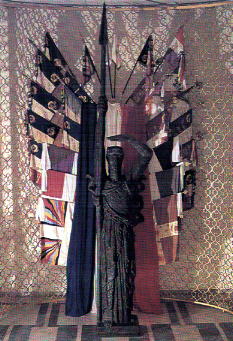![]() CHARLES FAIR
CHARLES FAIR
![]()
Another Great War site in eastern Brittany is Camp Coetquidan, which is about 30 miles West of Rennes. The camp, with its adjacent training area was, I believe, used by the French Army before WWI. In 1917-18 the AEF used it as a base. (It is mentioned in "Facing Armageddon" eds. P. Liddle and H, Cecil, pub 1996 - see the chapter on the experience of the US soldier.) The 42nd (Rainbow) Division was based there for a time. There are several pages about training in the camp in the book "The Rainbow Division" by J Cooke. One of its officers was a certain Douglas MacArthur, so he may well have served here.
The other reason for interest in Coetquidan is that it is now one of the major centres for oficer training in the French Army. The St. Cyr officer training academy moved much of its activity here from near Versailles in the 1960s. It is rather as if Sandhurst was moved to a small Cornish village on the edge of Bodmin Moor and was housed in a 1960s concrete campus. The buildings themselves are of no great interest but there are a large number of statues to various marshals and generals. However there is an excellent museum (in French) devoted to the history of officer training in the French Army.
| The museum contains numerous Great War photographs, uniforms and other memorabilia. It also contains the Monument aux Morts of the school. This is a bronze statue by the sculptor Antoine Bourdelle. The statue depicts France, in mythical costume, watching the horizon: one hand protects her eyes while the other holds a long spear. She originally stood near the mouth of the Gironde near Bordeaux, representing France watching for and welcoming the US troops who came via the Atlantic ports in 1917-18 in an echo of the Statue of Liberty. An identical statue is outside the Musee d'Art Moderne in Paris. |  |
I was particularly intrigued by a memorial archive there which commemorates those who died "Pour la Patrie". The archive contains service details, medal citations and in most cases a photograph of each officer. St Cyr was founded in 1803, and 61,292 had graduated from it up to 1990. Of these, 10,624 died for France, of which 4,848 were in the Great War alone. By comparison WWII accounts for only 1,374 of the total.
I purchased a copy of the Roll of Honour (30 FF), a document that merits a detailed analysis and a paper to itself. However, it does show that the mortality rates climb steadily in the twenty years of classes that precede the Great War. The class of 1913-14, and the accelerated class of 1914, have the highest mortality rates of all at over 60 per cent. The vast majority of these casualties were during the Great War, and of these, a rough glance leads me to estimate that about 70 per cent were killed in the battles of 1914 and 1915. The devastating effects of the early phases of the war on the French officer corps need no better illustration.
![]()
 Copyright © Charles Fair, May,
1997.
Copyright © Charles Fair, May,
1997.
Return to the Charles Fair Battlefield Guide START page
Return to the Hellfire Corner Contents Section
|